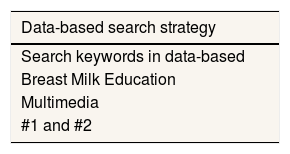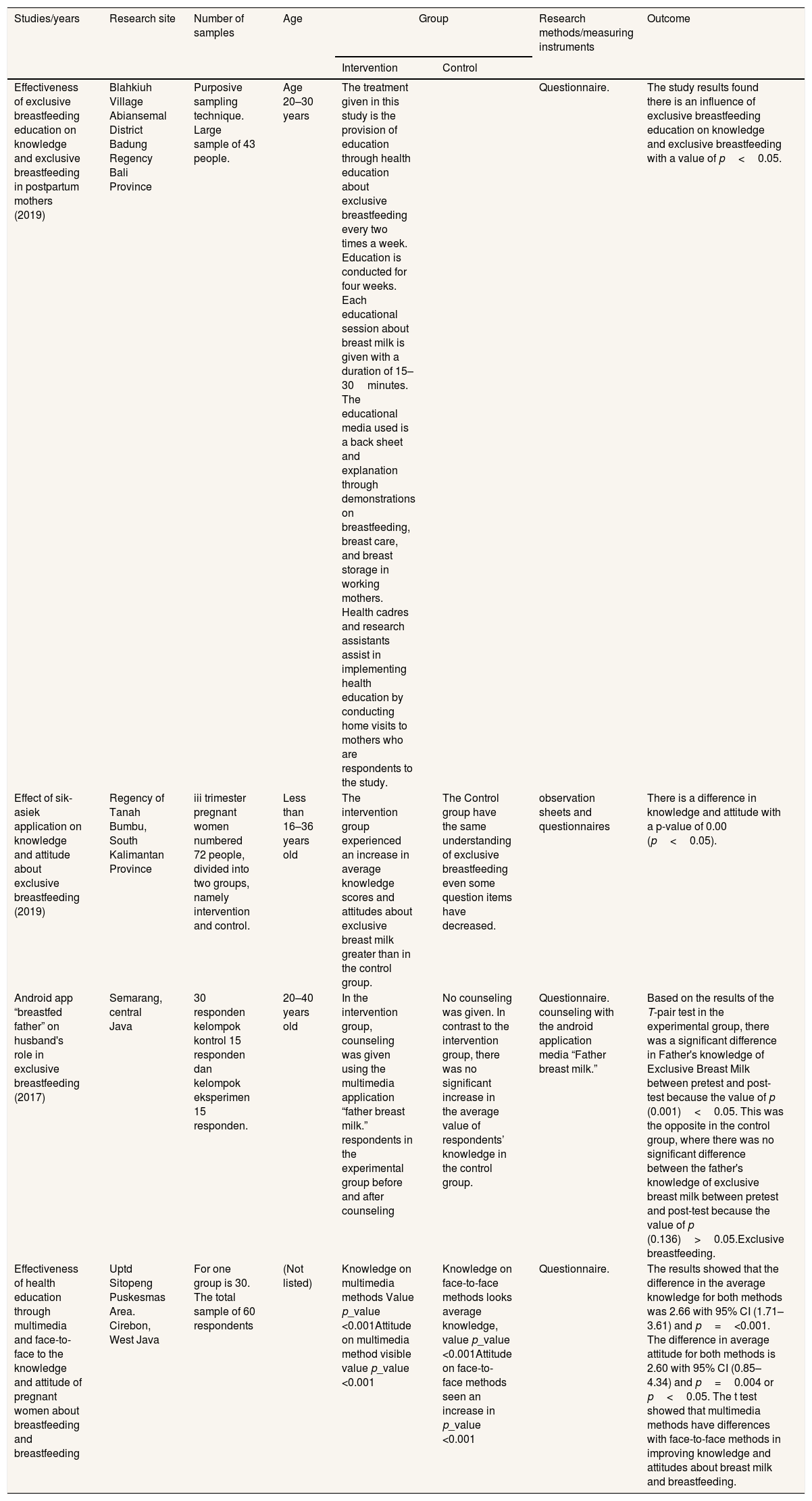
The 3rd International Nursing and Health Sciences Students and Health Care Professionals Conference (INHSP)
More infoAnalyzing the educational media of breast milk, whether breast milk education media can increase knowledge about breast milk.
MethodArticle search using Proquest, Sciencedirect, Pubmed, and Scholar to find articles that fit the criteria for inclusion and exclusion is then reviewed.
ResultMultimedia is good in improving the knowledge and attitude of mothers in giving breast milk. Multimedia with a change rate of 4.53 with SD 1.99. For attitudes, the analysis of attitude changes in multimedia methods is 3.77 with SD 4.24.
ConclusionMultimedia can help improve knowledge about breast milk.
Breast milk is a fat emulsion in protein, lactose, and organic salts secreted by both breast glands of the mother as the primary food for babies. Breast milk is the best living fluid that babies need. However, there are still many mothers who do not want to breastfeed their babies for various reasons. In Indonesia, the number of mothers who give breast milk to babies is minimal, even though the National target reaches 80%. This is due to the lack of knowledge about breast milk, whereas the nutritional content of breast milk can meet the baby's needs.1
Educational media is a tool that explains part or all of the learning program that is difficult to explain verbally. Educational media can be learning materials, training questions, videos, games, and others. Android-based educational media provides its nuances for students. Using audio visual, teaching materials that are difficult to explain descriptively can be simulated easily either in video or animation, even into a game.2
Due to customs and culture and poor perception of breast milk, causing many mothers not to give breast milk to their babies, therefore it is expected that education about breast milk can motivate mothers to breastfeed their babies so that the number of mothers who breastfeed their babies can increase from year to year and later be able to reach the national target figures.3
With the support of theory and literature study conducted on mothers who use multimedia as an education about breast milk, the author is interested to find out how effectively education with multimedia can increase maternal knowledge?
MethodsThe research design reviewed in this literature review uses quasi-experiment design and pretest and post-test group control group. Instruments in the study were reviewed using questionnaires. Reviewed study types use multimedia to help improve knowledge. Articles reviewed are limited to multimedia in the form of applications as samples observed in the literature review.
Included in the inclusion criteria are educational interventions using multimedia with limited effect on improving knowledge. The literature review uses published articles. Searches were done using Proquest, PubMed, and Google (Scholar) with selected variable keywords. The articles that have been obtained are read and studied, and selected using the inclusion criteria that have been set by the author to be used as a literature review. Article search is limited only from 2011 to 2020, accessed in PDF format, and has a quasi-experimental design and post-test pretest. Published research articles that conduct multimedia education proven to increase knowledge will be included in the literature review (Table 1).
Articles to be analyzed. Extracted and synthesized then determined its evidence. After obtaining the results of the analysis of articles that new authors have done can conclude the effects of the use of multimedia education.
The data extracted from the article into a table form are the title of the study, the researcher's name, the year of publication, the method, the number of samples from the intervention group, the tools used when the study was complete with its significance value after the entire article is read and analyzed and then extracted in the form of a table to make the reader easier to understand.
ResultPredefined keywords are used to search for articles, and subsequently, the articles obtained are sorted based on predetermined criteria. After being selected four articles, the four articles were then analyzed. Below are four lists of articles extracted into table form (Fig. 1).
From the search for articles conducted, there are four articles, the research methods of articles analyzed are diverse, the research methods are quasi-experiments, post-test design with one group or two groups. The research places are all in Indonesia but different provinces, namely Bali, South Kalimantan, Central Java, and West Java. The first article of the study results had the effect of increasing knowledge after breastfeeding with a value of p<0.05. The second article showed a difference in knowledge improvement between the two groups with a p-value of 0.00 (p<0.05). We can see the difference in improvement both in attitude and knowledge. The third article's results showed differences in knowledge improvement between the intervention and control groups with a value of p: 0.001 (Table 2).
Extraction of Data.
| Studies/years | Research site | Number of samples | Age | Group | Research methods/measuring instruments | Outcome | |
|---|---|---|---|---|---|---|---|
| Intervention | Control | ||||||
| Effectiveness of exclusive breastfeeding education on knowledge and exclusive breastfeeding in postpartum mothers (2019) | Blahkiuh Village Abiansemal District Badung Regency Bali Province | Purposive sampling technique. Large sample of 43 people. | Age 20–30 years | The treatment given in this study is the provision of education through health education about exclusive breastfeeding every two times a week. Education is conducted for four weeks. Each educational session about breast milk is given with a duration of 15–30minutes. The educational media used is a back sheet and explanation through demonstrations on breastfeeding, breast care, and breast storage in working mothers. Health cadres and research assistants assist in implementing health education by conducting home visits to mothers who are respondents to the study. | Questionnaire. | The study results found there is an influence of exclusive breastfeeding education on knowledge and exclusive breastfeeding with a value of p<0.05. | |
| Effect of sik-asiek application on knowledge and attitude about exclusive breastfeeding (2019) | Regency of Tanah Bumbu, South Kalimantan Province | iii trimester pregnant women numbered 72 people, divided into two groups, namely intervention and control. | Less than 16–36 years old | The intervention group experienced an increase in average knowledge scores and attitudes about exclusive breast milk greater than in the control group. | The Control group have the same understanding of exclusive breastfeeding even some question items have decreased. | observation sheets and questionnaires | There is a difference in knowledge and attitude with a p-value of 0.00 (p<0.05). |
| Android app “breastfed father” on husband's role in exclusive breastfeeding (2017) | Semarang, central Java | 30 responden kelompok kontrol 15 responden dan kelompok eksperimen 15 responden. | 20–40 years old | In the intervention group, counseling was given using the multimedia application “father breast milk.” respondents in the experimental group before and after counseling | No counseling was given. In contrast to the intervention group, there was no significant increase in the average value of respondents’ knowledge in the control group. | Questionnaire. counseling with the android application media “Father breast milk.” | Based on the results of the T-pair test in the experimental group, there was a significant difference in Father's knowledge of Exclusive Breast Milk between pretest and post-test because the value of p (0.001)<0.05. This was the opposite in the control group, where there was no significant difference between the father's knowledge of exclusive breast milk between pretest and post-test because the value of p (0.136)>0.05.Exclusive breastfeeding. |
| Effectiveness of health education through multimedia and face-to-face to the knowledge and attitude of pregnant women about breastfeeding and breastfeeding | Uptd Sitopeng Puskesmas Area. Cirebon, West Java | For one group is 30. The total sample of 60 respondents | (Not listed) | Knowledge on multimedia methods Value p_value <0.001Attitude on multimedia method visible value p_value <0.001 | Knowledge on face-to-face methods looks average knowledge, value p_value <0.001Attitude on face-to-face methods seen an increase in p_value <0.001 | Questionnaire. | The results showed that the difference in the average knowledge for both methods was 2.66 with 95% CI (1.71–3.61) and p=<0.001. The difference in average attitude for both methods is 2.60 with 95% CI (0.85–4.34) and p=0.004 or p<0.05. The t test showed that multimedia methods have differences with face-to-face methods in improving knowledge and attitudes about breast milk and breastfeeding. |
The difference in average attitude for both methods is 2.60 with 95% CI (0.85–4.34) and p=0.004 or p<0.05. The t-test showed that multimedia methods have differences from face-to-face methods in improving knowledge and attitudes about breast milk and breastfeeding.
DiscussionDetermination of inclusion criteria in finding articles to be created literature review shows affects the results of the number of articles that match the criteria that have been set. Articles using quasi-experimental methods and one group of post-test design from 2011 until 2021 are very limited in number. Therefore the authors also include research with two groups, and that is still related to educational media as one of the articles to be analyzed. The results obtained in the end only obtained four research articles on breast milk education media. After the article was read, the results showed that education through the media could increase knowledge and change the attitude of mothers and fathers to support breastfeeding.4 Media in health education can be diverse. Today, the use of information technology is vigorous.5
Articles about the use of media as breast milk education are still less published, but the article found can already be used as a reference because the article displayed is an article that has been published from good literature and official. The number of articles discussing influence is also strong enough to prove that educational media is very good to improve people's knowledge. In the future, more and more breast milk education media is expected so that the public will know more about the benefits of breast milk, and it is expected that people are encouraged by their motivation to give breast milk to their children.6
ConclusionThe results of the literature review that has been done show that there is an increase in knowledge by using educational media. Not only knowledge but also the attitude and perception of breast milk are getting better, so it motivates mothers and fathers to support exclusive breastfeeding programs in their children.
Conflicts of interestThe authors declare no conflict of interest.
Peer-review under responsibility of the scientific committee of the 3rd International Nursing, Health Science Students & Health Care Professionals Conference. Full-text and the content of it is under responsibility of authors of the article.

















